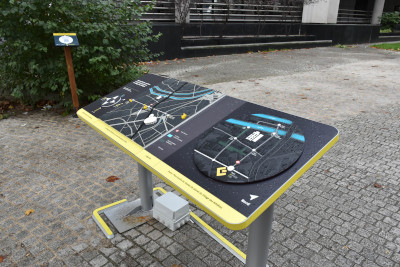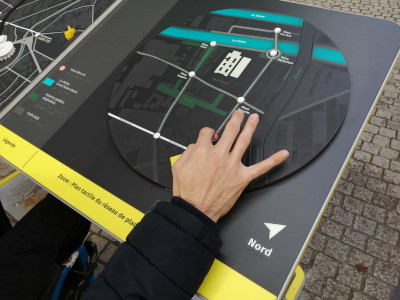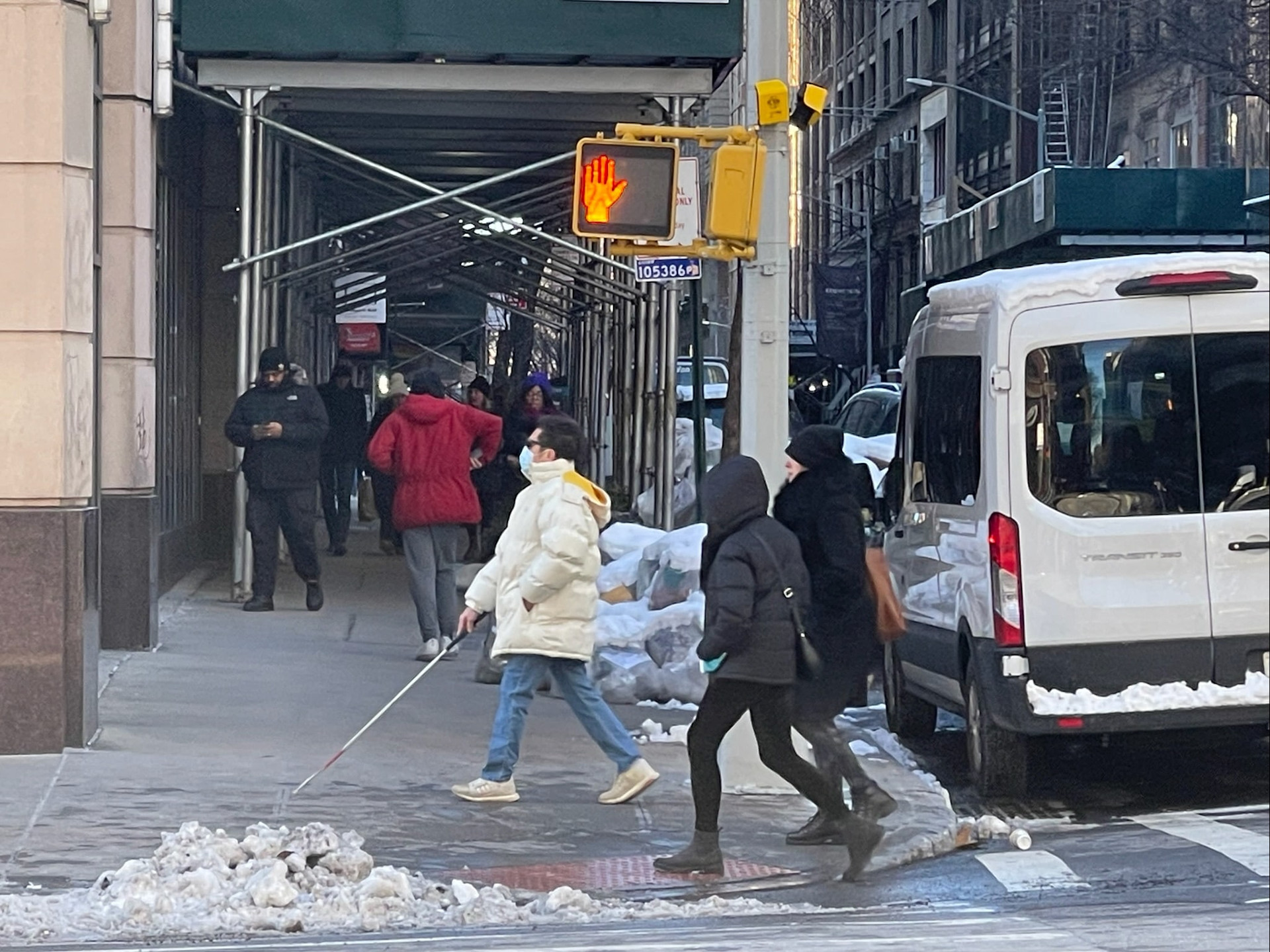Accessibility will have a new face at the Olympic and Paralympic Village in Greater Paris.

Creating Inclusive Multisensory Signage for People with Disabilities

Creating Inclusive Multisensory Signage for People with Disabilities
Maybe you think that inclusive multisensory signage is more of an utopia, that it’s impossible to include all the different types of disabilities. Well it’s definitely possible. And that’s what we’ve conceived.
It all started when SOLIDEO, the French company in charge of setting up infrastructures to welcome international athletes at the Olympic and Paralympic Village, chose Okeenea and and 5 other accessibility expert companies to conceive signage solutions.
It’s true that usually the Games shine a light on the hosting city. Next year, all eyes will turn to Paris. This represents an opportunity to rethink inclusion.
What are the needs of people with disabilities? Can a multisensory signage system be implemented at the scale of a city? Can residents get to grips with it in their everyday lives?
Inclusive multisensory signage: universal accessibility at the doorsteps of Paris
Next year, Paris will host the most prestigious international sporting event. The challenge is huge for French company SOLIDEO.
Its goal is to build durable infrastructures and to implement innovative solutions that’ll improve tomorrow’s city.
This means focusing on universal accessibility and taking into account the needs of people with disabilities, whatever their capabilities are. Because disabilities are indeed plural.
SOLIDEO launched a call for innovations on inclusive multisensory signage solutions. We’ve been chosen along 5 other accessibility expert companies to tackle this challenge. Together we’ve become the OMNISENS consortium.
The inclusive multisensory signage solutions we’ve created are meant to be set up once the competition is over. It’s great because it means that they’ll residents with disabilities find their way in the area.
Every person that needs inclusive multisensory signage to enjoy the neighborhood and its infrastructures will be free to do so without having to think twice about accessibility.
What solutions are part of an inclusive multisensory signage system?
One thing is sure: developing inclusive solutions to guide people with disabilities isn’t an easy task. Because this means taking into account all types of disabilities and capabilities.
But what matters is that these solutions are meant to improve the autonomy of people with disabilities.
Directional guide paths
Blind and visually impaired people usually find guide paths thanks to their white cane or their guide dog. They can feel the directional raised surfaces and follow the tactile paving by themselves.
We’ve come up with innovative guide paths. They provide another detection method.
When a visually impaired person locates these guide paths with their white cane, this creates a vibration. In a way, it works like a foldback.
The material of the guide paths, aluminum, but mostly their fixing method creates this foldback. Indeed, these guide paths are screwed. They’re not completely glued to the ground.

Crossing guide paths
These guide paths are quite different from the previous ones. They’re located on the pedestrian crossing.
Their purpose is to help blind and visually impaired pedestrians maintain their course when crossing the street.
Actually, nobody walks straight. But for a person with vision disabilities, it can be more challenging to walk straight when crossing.
Tactile paving to point to a specific point of interest
In France, this type of tactile paving is very common. Its goal is to guide the visually impaired from the main path to a specific point of interest.
It enables a person with a visual impairment to find the emergency phone at a subway station or the ticket machine at a tram stop.
As part of the inclusive multisensory signage we’ve created, this tactile paving is meant to help a blind pedestrian find the crossing.
Accessible pedestrian crossings
That goes without saying that there are indeed accessible pedestrian signals at the area of the Olympic and Paralympic Village for athletes and residents with vision disabilities.
But what can be done for intersections without traffic lights?
Well there can still be audio signage to enable the visually impaired to cross the street with complete autonomy.
We’ve installed audio beacons on both sides of a crossing without traffic lights. Just like regular APS, they can be actuated with:
⊗ A remote control
⊗ MyMoveo, a free smartphone app
Audio beacons at bus stops
To be able to come and go, people with visual impairments need to rely on public transportation.
But to hop on and off the bus, they first need to find the bus stop.
That’s another use for audio beacons. They can be implemented at all types of points of interest.
Directional poles
To easily find our way to venues, we all need directions. We’ve come up with inclusive directional poles to guide people with disabilities:
⊗ Easy-to-read textual information for people with intellectual disabilities,
⊗ Visual contrast for the visually impaired,
⊗ Accessible font for people with dys disorders,
⊗ Audio beacons for blind people: the messages let them know in which direction the venues nearby are located.

Linear cartography
This is another solution to provide information to all types of users, whether they have disabilities or not.
This equipment has visual, tactile and audio signage. It’s entirely intuitive and inclusive.
Multisensory maps
It’s a similar solution as the linear cartography but the format is different. It makes it easy to use for everybody.
This zooms in on a particular area of the neighborhood.

Collecting accessibility data
When a person with disabilities gets around in a city, they need to know beforehand what’s accessible to them.
That’s where accessibility data steps in. We focus on collecting this data and translating it to make it available for every type of user.
Every step of the way, people with disabilities can know how to reach a venue and what’s truly accessible within it.
In fact, accessibility data provides more context to users. This digital asset represents an opportunity to enhance accessibility and inclusion.
Using digital solutions enables us to complete the physical accessibility equipment that’s installed.
Conceiving inclusive multisensory signage with and for people with disabilities
We followed specific methods and organized two series of tests with people with disabilities to create the best possible solutions.
Thanks to these tests, we were able to take into account all disability types. Plus, they tested all the solutions we’ve conceived. This means a wheelchair user could give his opinion on our audio beacons.
Because what matters is that these solutions are helpful and comfortable for everyone. We kept adjusting and rethinking them to truly meet everybody’s needs.
We wouldn’t have conceived inclusive multisensory solutions without the feedback from people with disabilities.
This signage is flowing and coherent for all parties involved. It helps maintain a seamless mobility chain.

Why is it so important to foster accessibility and inclusion for all?
⊗ It provides more equity, freedom and spontaneity to people with disabilities.
⊗ It leaves no one behind or aside.
⊗ It means “fixing up” our public spaces by making them accessible.
For sure, accessibility is usually under the spotlight for such big events but that doesn’t mean it’s discarded once they’re over.
For example, Tokyo, Japan, improved its accessibility because of the games. It ended up making the lives of residents with disabilities easier afterwards because the city kept its accessibility equipment.
Olympic Games Tokyo 2020: Accessibility Equipment Update
Who is behind the creation of this inclusive multisensory signage?
Okeenea combined their expertise with that of 5 other companies. Thanks to OMNISENS, people with disabilities will benefit from solutions that perfectly cater to their needs.
We’re proud to make inclusion a reality for them and other people with disabilities who’ll enjoy our inclusive multisensory signage solutions once the competition is over.
Okeenea
Okeenea is the accessibility leader in France. Since the invention of accessible pedestrian signals, they’re committed to improving the everyday lives of people with disabilities thanks to innovative accessibility solutions for public works but also for buildings.
Tactile Studio
An inclusive design agency, Tactile Studio is a leader in creating accessible visitor experiences for cultural institutions around the world. It has been conceptualizing and producing multisensory and hybrid tours for over 10 years.
Atipy
Their DNA: universal design. Atipy regoups 3 agencies and a design office. They support local authorities, cities, communities, associations and institutions in their inclusive projects.
Empreinte signalétique
Empreinte signalétique develops custom signage projects installed in France and abroad. Their products can be adapted to both remarkable sites and corporate headquarters, and are suitable for natural spaces and urban environments.
Mengrov
Mengrov is a community design agency that co-creates solutions that enhance the strength of singularities. In an approach that combines design and strategy, they develop a sensitive approach that combines decoding societal issues and listening to expectations.
Polygraphik
Based at the meeting point of signs, objects and space, the Polygraphik studio – founded in 2009 by designers Sébastien Nicot and Juliette Cheval – specializes in signage design. Its role is to make a place comprehensible so that the user can orient himself and move around independently.
Maybe you’re wondering how we’ve managed to create all these different inclusive multisensory signage solutions.
Keep in mind this:
1. Disabilities have always driven innovation. After all, to include people that society usually puts aside, we need to think outside the box.
2. It’s the combination of physical and digital accessibility that creates inclusive spaces.
Want to find out more about digital solutions that improve accessibility? Check out our articles:
Open Data Is Key to Fostering Universal Accessibility
What Is a Phygital Experience and How Can It Improve the Accessibility of Your Venue?
Published on May 26th, 2023
media

We followed specific methods and organized two series of tests with people with disabilities to create the best possible solutions. (…) Because what matters is that they’re helpful and comfortable for everyone. We kept adjusting and rethinking them to truly meet everybody’s needs.
writer

Carole Martinez
Content Manager & Copywriter
stay updated
Get the latest news about accessibility and the Smart City.
other articles for you

Open Data Is Key to Fostering Universal Accessibility
Open data represents an opportunity for cities to reach universal accessibility. It shows the missing links of the mobility chain.
Our Audio Beacons Guide the Blind and Visually Impaired at the Helsinki Subway
The Helsinky subway improved their audio signage system by installing on demand and remotely activated audio beacons.
7 Good Reasons to Install Audio Beacons at Your Public Transport Network
Audio beacons are an efficient way to provide more autonomy to blind and visually impaired people. They can easily use public transport.

Will Remote Activation Become the Norm for Accessible Pedestrian Signals?
More and more cities like New York have been exploring remote activation to trigger accessible pedestrian signals.
share our article!
more articles

Disability Statistics in the US: Looking Beyond Figures for an Accessible and Inclusive Society
Disability Statistics in the US: Looking Beyond Figures for an Accessible and Inclusive Society Around 61 million adults in the United States live with a disability. Diving into disability statistics in the US will help us know exactly who is concerned and what...
Our Audio Beacons Guide the Blind and Visually Impaired at the Helsinki Subway
Our Audio Beacons Guide the Blind and Visually Impaired at the Helsinki SubwayOur audio beacons equip the new line of the Helsinki subway in Finland. They help blind and visually impaired people locate the points of interest of a station. For users with visual...

Will Remote Activation Become the Norm for Accessible Pedestrian Signals?
Will Remote Activation Become the Norm for Accessible Pedestrian Signals?Without pushbutton, there are no accessible pedestrian signals. That’s how APS work in the U.S. But more and more cities have been exploring remote activation like New York City. The Department...

Hearing Impaired People: a Multitude of Profiles for Different Needs
Hearing Impaired People: a Multitude of Profiles for Different Needs Did you know that hearing impaired people have several profiles and that the way they identify themselves is important? You may be familiar with deaf and hard of hearing people but for each of...
NEVER miss the latest news about the Smart City.
Sign up now for our newsletter.
Unsubscribe in one click. The information collected is confidential and kept safe.
powered by okeenea
The French leading company
on the accessibility market.
For more than 25 years, we have been developing architectural access solutions for buildings and streets. Everyday, we rethink today’s cities to transform them in smart cities accessible to everyone.
By creating solutions ever more tailored to the needs of people with disabilities, we push the limits, constantly improve the urban life and make the cities more enjoyable for the growing majority.








Recent Comments